PESTS AND DISEASES OF FORESTRY IN NEW ZEALAND
Insect parasites of Sirex
Scion is the leading provider of forest-related knowledge in New Zealand
Formerly known as the Forest Research Institute, Scion has been a leader in research relating to forest health for over 50 years. The Rotorua-based Crown Research Institute continues to provide science that will protect all forests from damage caused by insect pests, pathogens and weeds. The information presented below arises from these research activities.
Forest and Timber Insects in New Zealand No. 47: Insect parasites of sirex.
(This leaflet should be read in conjunction with No. 20 Sirex and No. 48 Nematode parasite of sirex)
Based on M.J. Nuttall (1980)
Insect: (Hymenoptera: Ichneumonidae, Ibaliidae, and Orussidae)
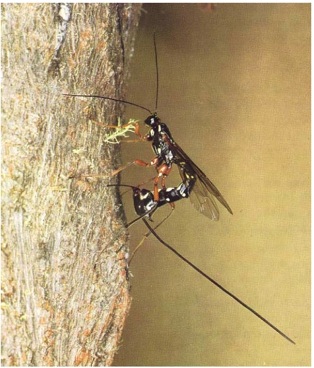
Fig. 1 - Rhyssa persuasoria persuasoria drilling into a radiata pine tree to sting, paralyse, and lay an egg on sirex larva. The ovipositor (entering the wood between the middle legs) is as long as the ovipositor sheaths which project to the rear (x1.5).
Type of injury
As described in leaflet No. 20, the sirex woodwasp Sirex noctilio F. a European insect accidentally introduced into New Zealand before 1900, inserts eggs, a phytotoxic mucus, and arthrospores of the fungus Amylostereum areolatum (Fries) Boidin into the wood of living pine trees and occasionally into larch and spruce. The combined effect of the mucus and fungus may kill susceptible trees. The sirex larvae tunnel for one or two years in the fungus-affected wood, pupate, and emerge during the summer as winged adults. Larvae of certain parasitic insects destroy sirex larvae but cause no further damage to the tree; the holes made by adult parasites when emerging are also of no importance since the trees, or parts of trees, in which they occur are already dead as a result of successful sirex attack.
Hosts
In New Zealand sirex is the only host of the established introduced parasitic insects Rhyssa persuasoria persuasoria (L.), R. lineolata (Kirby), and Megarhyssa nortoni nortoni (Cresson) (Hymenoptera: Ichneumonidae), and the two subspecies of Ibalia leucospoides (Hochenwarth) (Hymenoptera: Ibaliidae).
Sirex larvae are sometimes also attacked by the native parasite Guiglia schauinslandi (Ashmead) (Hymenoptera : Orussidae), although the usual hosts of this parasite are larvae of pit weevils
(Psepholax) and a longhorn beetle Calliprason pallidus (Pascoe).
Distribution
Rhyssa persuasoria persuasoria was deliberately introduced as a control measure from Europe in 1928-29 and in 1931, and is well established throughout our exotic pine forests. Rhyssa lineolata from North America was first discovered in New Zealand in 1955 and probably entered the country accidentally in timber cut from woodwasp-infested trees. It is known to be naturally established in six forests in the southern half of the North Island, and has been recovered from Waitangi following release in the forest there. Megarhyssa nortoni nortoni was deliberately introduced from North America in 1962 and 1964 and was first liberated in 1964. It is known to be established in 21 forests. Ibalia leucospoides leucospoides, deliberately brought from Europe in 1950 and 1951 and first liberated in 1954, is well established almost everywhere sirex occurs in New Zealand. Ibalia leucospoides ensiger a subspecies from North America, was first released in 1966 and has been recovered from seven forests. It interbreeds with the already well-established I. leucospoides leucospoides. Guiglia schauinslandi probably occurs throughout New Zealand wherever its hosts are present.
Economic importance
The complex of introduced parasitic insects may kill over 70% of sirex larvae in a particular forest area. Guiglia schauinslandi parasitises few sirex larvae and is of little significance. (Other factors controlling sirex are the presence of a nematode (Deladenus siricidicola Bedding) which can sterilise the sirex female, and most importantly, good forest management to encourage vigorous growth of trees and thereby increase their resistance to sirex attack.)
Description
All the insect parasites have two pairs of veined, transparent, membraneous wings. The females have a thin, flexible ovipositor (egg-laying drill), the walls of which consist of three parts. These parts fit together along their length to form a tube down which the egg passes. Two of the parts, which run in grooves in the third part, are serrated at the tip and act as vertical saws. The size of the adult parasite depends on how large the parasite larva was able to grow, and this in turn is determined by the size of the host sirex larva. Rhyssa persuasoria persuasoria (Fig. 2) has a black body with spots of white on the head, thorax, and abdomen. These spots vary in size and number for some individuals appear almost wholly black. The legs are reddish brown, and the antennae completely black. Body length (measured from front of head to end of abdomen) can be from 9 mm in the smallest male up to 35 mm for the largest female. The ovipositor is slightly longer than the female's body and when not in use projects straight out behind her enclosed between two protective sheaths. The male has an elongated abdomen slightly swollen towards the rear.
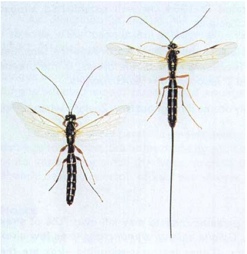
Fig 2 - Rhyssa persuasoria persuasoria adults: male on the left, female on the right. Actual size.
Rhyssa lineolata (Fig. 3) is similar in size and shape to R. persuasoria persuasoria but the white markings are more numerous. A distinctive feature on all specimens except the very smallest males is the white band just past the middle of each antenna.
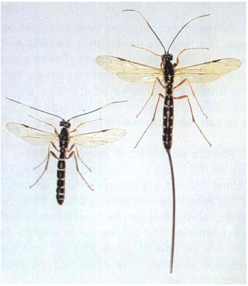
Fig. 3 - Rhyssa lineolata adults: male on the left, female on the right. Actual size.
Megarhyssa nortoni nortoni (Fig. 4) is brown, black, and yellow, and has a row of oval yellow spots along each side of the abdomen. Legs are mostly yellow or light brown, and the antennae are all black. Body length can range from 15 mm to 45 mm. The ovipositor is similar to that of Rhyssa but is about twice as long as the body. The abdomen of the male is usually long and narrow, but in very small specimens it becomes slightly swollen.
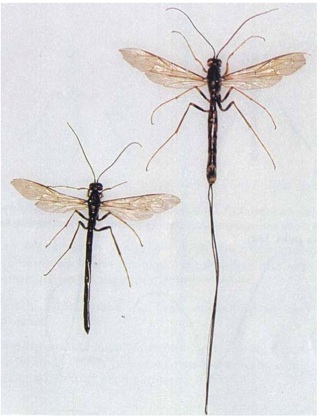
Fig. 4 - Megarhyssa nortoni nortoni adults. male on the left, female on the right. Actual size.
Ibalia leucospoides leucospoides (Fig. 5) has a dark brown abdomen and black head, thorax, legs, and antennae. The body can be from 5 mm to 16 mm long, and the wingspan 8 mm to 23 mm. When not in use the ovipositor is retracted inside the body. The most distinctive feature of both sexes is the abdomen which is so flattened at the sides that when viewed from above it looks like the sharp edge of a knife. The abdomen of the male when seen side on is, however, less angulate than that of the female (Fig. 6). The male also has a small notch on the outside edge of each antenna where it joins the head.
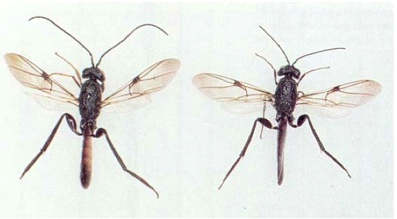
Fig. 5 - Ibalia leucospoides leucospoides adults: male on the left, female on the right (x2).
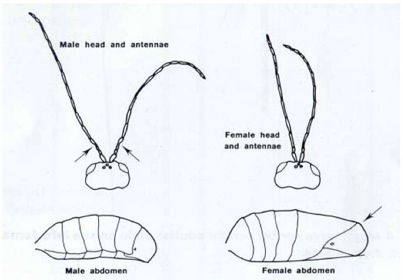
Fig. 6 - Ibalia - top view of heads and antennae, and side view of abdomens. Male has notch (arrowed) on outer side of third antennal segment. Abdomen of female is more sharply angled (arrowed) than that of male (x3.5).
Ibalia leucospoides ensiger is the same shape and size as I. leucospoides leucospoides, but its abdomen is light brown. The females have a dark mark towards the top rear of the abdomen. Progeny arising from interbreeding with I. leucospoides leucospoides usually lack these colour differences.
Guiglia schauinslandi (Fig. 7) is stout bodied, black, and between 5 mm and 12 mm long. The end segments of the antennae of the female are more thickened than those of the male, and have a peg- like tip. The female can also be recognised by the groove for the retractile ovipositor on the underside of the last abdominal segment.
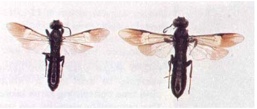
Fig. 7 - Guiglia schauinslandi adults: male on the left, female on the right (x2).
Larvae (Fig. 8) present in sirex tunnels can be identified as follows:
- Sirex: Cylindrical, yellowish-white grubs with rudimentary legs and hard, black tail spine.
- Rhyssa and Megarhyssa: White or yellowish-white grubs, somewhat tapered towards each end, no legs, no tail spine, and with a brown V- shaped structure under the mouth.
- Ibalia: Smooth, white grubs, no legs, no tail spine, and with small horizontal jaws.
- Guiglia: White grubs with small horizontal jaws, no legs, no tail spine, and with a row of small spines (which can just be seen by using a hand lens) on the upper surface of each segment.
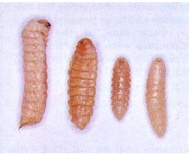
Fig. 8 - Larvae which may be present in sirex tunnels. From left to right Sirex; Rhyssa (or Megarhyssa); Ibalia; Guiglia (x1.5).
Life history and habits
Rhyssa and Megarhyssa: The rhyssine parasites are attracted by smell to trees which contain sirex fungus. The female drills randomly into the wood with her ovipositor until she reaches a sirex larva which she stings and paralyses (Fig. 1, 9, and 10). An egg then passes down her ovipositor on to the sirex larva. The egg can hatch in two days, and the parasite larva then eats the sirex larva; this generally takes about five weeks, but can take as little as 14 days.
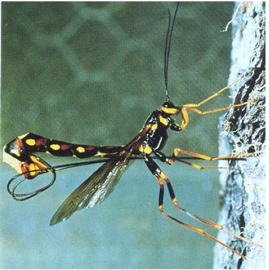
Fig. 9 - Megarhyssa nortoni nortoni starting to drill into a radiata pine tree containing sirex larvae. The ovipositor sheaths are used to guide the ovipositor into the wood (x1.5).
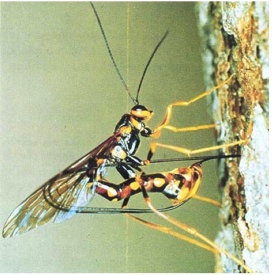
Fig. 10 - Megarhyssa nortoni nortoni with ovipositor almost fully in the wood. Note how the sheaths have continued to guide the ovipositor and have become looped on each side of the body (compare with the attitude of R. persuasoria persuasoria in Fig. 1) (x1.5).
The rhyssine larva does not bore in the wood, but remains in the sirex tunnel, usually for nearly a year, before pupating (Fig. 11 ). Adults bite their way out of the wood and most emerge in spring. Males start emerging slightly earlier than females and may sometimes be attracted to places on the bark where they expect a female to come out (Fig. 12). Some of the adults which appear in summer can be progeny from the same season's oviposition and may have spent as little as eight weeks as larvae and pupae in the wood.
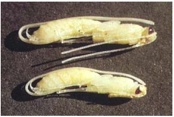
Fig. 11 - Female Rhyssa pupae. The ovipositor curls over the back to reach as far as the head (in Megarhyssa female pupae the much longer ovipositor continues down in front of the head and bends underneath the body) (x1.3).
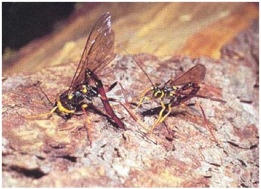
Fig. 12 - Precopulatory activity by male Megarhyssa on bark of ponderosa pine at a spot where a Megarhyssa female later emerged (actual size).
The adult can obtain essential carbohydrate by eating the honeydew excreted by scale insects and aphids. In our pine forests the most common source of such food is produced by scale insects on "blighted" manuka (Leptospermum scoparium). Rhyssines may also feed on nectar, but owing to their chewing-lapping type of mouth they can take it only from flowers which have an open, flat shape. Without food adults may live for about nine days, but if food is available not only is their life span increased to one or two months, but their egg-laying activity is also greater. Not only sirex larvae but also pupae, and even adults before they emerge from the wood, can be parasitised by rhyssines.
Ibalia: The female Ibalia detects by smell a recent drill hole made by sirex when egg laying. She then lowers her ovipositor into the hole (Fig. 13), drills into the sirex egg, and deposits an egg into the body of the developing sirex larva. By the time the sirex larva hatches and bores into the wood, it has an Ibalia parasite larva inside it. If the sirex larva has already hatched before discovery by Ibalia it can still be parasitised provided it has not yet moved away from the egg laying site.
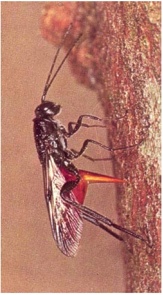
Fig. 13 - Ibalia female egg-laying down a drill hole made by a sirex female in living radiata pine. The triangular process pointing into the wood is part of the underside of the parasite which she lowers as a guide for her fine, hair-like ovipositor (x3).
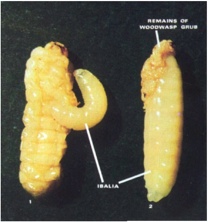
Fig. 14 - The first two and part of the third stages of growth of an Ibalia larva are spent inside the sirex larva. The third stage bites its way out (1), and eats the sirex larvae from the outside. The Ibalia larva then sheds its skin to become a fourth stage larva (2) which remains in the sirex tunnel and pupates (x2.75).
The Ibalia larva grows inside the sirex larva for several months, then bites its way out and eats the remains of the sirex larva (Fig. 14). It pupates in early summer, turns into an adult and chews its way out of the wood leaving a small round hole. As with the rhyssines, the males start emerging slightly earlier than the females (Fig. 15). Adult Ibalia live for several weeks, and although they can feed on honeydew they seem to manage quite well without doing so.
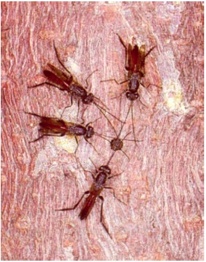
Fig. 15 - Male Ibalia around a recently cut hole through which a female later emerged (x1.25).
The female Guiglia drills her ovipositor into the wood to find and lay an egg on a sirex larva (Fig. 16). The parasite larva starts eating the sirex larva from the outside (Fig. 17), but may enter its body and finish it off from the inside once decomposition has started. Adults emerge in spring and early summer and live for several weeks.
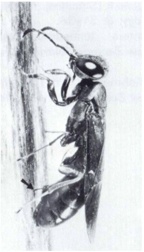
Fig. 16 - Guiglia schauinslandi drilling into a radiata pine tree containing sirex larvae.
Ovipositor arrowed (x4).
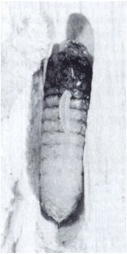
Fig. 17 - Guiglia schauinslandi larva eating sirex larva (x3.5).
The sex of the progeny of the rhyssines, Ibalia, and presumably Guiglia, is determined by fertilisation of the eggs: those laid by virgin females produce only males whereas both male and female offspring can be produced by mated females.
Multiple parasitism (when an individual host is attacked more than once by one or more species of parasite), or hyperparasitism (when one parasite attacks another parasite) can occur. Thus more than one Ibalia egg can be laid inside a developing sirex larva, and a sirex larva, (which may also have been parasitised by Ibalia) can have eggs laid on it by one or more rhyssine parasites or Guiglia. It is known that Guiglia can parasitise rhyssines, and that rhyssines can parasitise Ibalia. However only one parasite adult emerges after multiple parasitism or hyperparasitism in sirex, the others being eaten or dying of starvation at some earlier stage in their development.
Bibliography
Chrystal, R. N. 1930: Studies of the sirex parasites. The biology and post-embryonic development of Ibalia leucospoides Hochenw. (Hymenoptera: Cynipoidea). Oxford Forestry Memoirs No. 11.
Early, J.W. 1984: Parasites and predators pp 271-308 in: Scott, R.R. (ed.) New Zealand pest and beneficial insects. Lincoln University College of Agriculture, Canterbury. 373 p.
Hocking, H. 1967: The influence of food on longevity and oviposition in Rhyssa persuasoria (L.) (Hymenoptera: Ichneumonidae). Journal of the Australian Entomological Society 6: 83-88.
Morgan, D. F. and Stewart, N.C. 1966: The effect of Rhyssa persuasoria (L.) (Ichneumonidae) on a population of Sirex noctilio F. (Siricidae). Transactions of the Royal Society of New Zealand Zoology 8: 31-38.
Nuttall, M.J. 1974: Rhyssa lineolata (Hymenoptera: Ichneumonidae), as a parasite of Sirex noctilio in New Zealand. New Zealand Journal of Forestry Science 4: 487-494.
Nuttall, M.J. 1980: Insect parasites of sirex (Hymenoptera: Ichneumonidae, Ibaliidae, and Orussidae). Insect parasites of sirex. New Zealand Forest Service, Forest and Timber Insects in New Zealand No. 47.
Nuttall, M.J. 1989: Sirex noctilio F., sirex wood wasp (Hymenoptera: Siricidae) pp 299-306 in: Cameron, P.J.; Hill, R.L.; Bain, J. and Thomas, W.P. (eds.) A review of biological control of invertebrate pests and weeds in New Zealand 1874-1987. Technical Communication No. 10. CAB International, Wallingford, UK. 424 p.
Rawlings, G.B. 1957: Guiglia schauinslandi (Ashmead) (Hym. Orussidae) a parasite of Sirex noctilio (Fabricius) in New Zealand. The Entomologist 90 (1125): 35-36.
This information is intended for general interest only. It is not intended to be a substitute for specific specialist advice on any matter and should not be relied on for that purpose. Scion will not be liable for any direct, indirect, incidental, special, consequential or exemplary damages, loss of profits, or any other intangible losses that result from using the information provided on this site.
(Scion is the trading name of the New Zealand Forest Research Institute Limited.)



